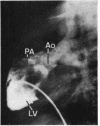Abstract
The clinical and anatomical findings in two patients with isolated ventricular inversion and situs solitus are described. The other 4 previously published cases are reviewed. The 6 patients with this malformation, all without pulmonary stenosis, presented a clinical picture of cyanotic congenital heart disease, associated with increased pulmonary blood flow (hypoxaemia and cardiac failure). The importance of different diagnostic tests is discussed and it is concluded that angiocardiography is the only definitive means of establishing the dianosis. Because the physiopathological disturbance is the same as in transposition of the great arteries, both malformations should be similarly considered with respect to diagnosis and treatment. Nevertheless, the high incidence of certain associated malformations in cases of isolated ventricular inversion adds to difficulty in diagnosis, and makes a good result from the Mustard procedure less likely than in transposition of the great arteries.
Full text
PDF











Images in this article
Selected References
These references are in PubMed. This may not be the complete list of references from this article.
- Pérez Trevino C., Hurtado del Río D., Holden A. M. Inversión ventricular aislada. Arch Inst Cardiol Mex. 1972 Nov-Dec;42(6):966–973. [PubMed] [Google Scholar]
- Van Praagh R., Van Praagh S. Isolated ventricular inversion. A consideration of the morphogenesis, definition and diagnosis of nontransposed and transposed great arteries. Am J Cardiol. 1966 Mar;17(3):395–406. doi: 10.1016/0002-9149(66)90222-0. [DOI] [PubMed] [Google Scholar]








